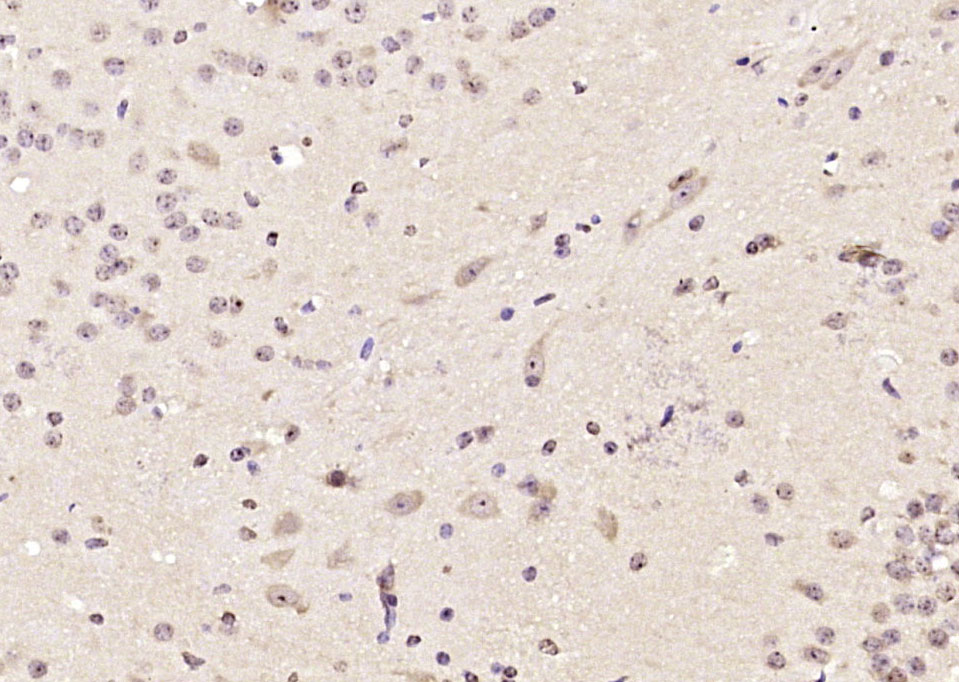
Rabbit Anti-COMMD1 antibody
C2orf5; COMD1; COMD1_HUMAN; COMM domain-containing protein 1; COMMD1; copper metabolism domain containing 1; MGC27155; MURR1; Protein Murr1.
View History [Clear]
Details
Product Name COMMD1 Chinese Name 铜代谢结构域蛋白1抗体 Alias C2orf5; COMD1; COMD1_HUMAN; COMM domain-containing protein 1; COMMD1; copper metabolism domain containing 1; MGC27155; MURR1; Protein Murr1. literatures Research Area Cell biology Signal transduction Epigenetics Immunogen Species Rabbit Clonality Polyclonal React Species Mouse, (predicted: Human, Rat, Cow, Horse, Rabbit, Sheep, ) Applications WB=1:500-2000 ELISA=1:5000-10000 IHC-P=1:100-500 IHC-F=1:100-500 IF=1:100-500 (Paraffin sections need antigen repair)
not yet tested in other applications.
optimal dilutions/concentrations should be determined by the end user.Theoretical molecular weight 21kDa Cellular localization The nucleus cytoplasmic Form Liquid Concentration 1mg/ml immunogen KLH conjugated synthetic peptide derived from human COMMD1/MURR1: 95-190/190 Lsotype IgG Purification affinity purified by Protein A Buffer Solution 0.01M TBS(pH7.4) with 1% BSA, 0.03% Proclin300 and 50% Glycerol. Storage Shipped at 4℃. Store at -20 °C for one year. Avoid repeated freeze/thaw cycles. Attention This product as supplied is intended for research use only, not for use in human, therapeutic or diagnostic applications. PubMed PubMed Product Detail Promotes ubiquitination of NF-kappa-B subunit RELA and its subsequent proteasomal degradation. Down-regulates NF-kappa-B activity. Down-regulates SOD1 activity by interfering with its homodimerization. Plays a role in copper ion homeostasis. Can bind one copper ion per monomer. May function to facilitate biliary copper excretion within hepatocytes.
Tissue specificity: Ubiquitous. Highest expression in the liver, with lower expression in brain, lung, placenta, pancreas, small intestine, heart, skeletal muscle, kidney and placenta.
Function:
Promotes ubiquitination of NF-kappa-B subunit RELA and its subsequent proteasomal degradation. Down-regulates NF-kappa-B activity. Down-regulates SOD1 activity by interfering with its homodimerization. Plays a role in copper ion homeostasis. Can bind one copper ion per monomer. May function to facilitate biliary copper excretion within hepatocytes.
Subunit:
Monomer and homodimer. Interacts (via COMM domain) with COMMD2, COMMD3, COMMD4, COMMD5, COMMD6, COMMD7, COMMD8 and COMMD10 (via COMM domain). Identified in a complex with an E3 ubiquitin ligase complex composed of TCEB1/elongin C, CUL2, SOCS1 and RBX1. Interacts directly with SOCS1 and CUL2. Interacts directly the N-terminal region of ATP7B. Interacts with CCS, CDKN2A, RELA and NFKBIB. Identified in a complex with NF-kappa-B. Interacts with CLU.
Tissue Specificity:
Ubiquitous. Highest expression in the liver, with lower expression in brain, lung, placenta, pancreas, small intestine, heart, skeletal muscle, kidney and placenta.
Post-translational modifications:
Ubiquitinated; undergoes both 'Lys-63'- and 'Lys-48'-linked polyubiquitination. Ubiquitinated by XIAP, leading to its proteasomal degradation.
Similarity:
Contains 1 COMM domain.
SWISS:
Q8N668
Gene ID:
150684
Database links:Entrez Gene: 150684 Human
Entrez Gene: 17846 Mouse
Omim: 607238 Human
SwissProt: Q8N668 Human
SwissProt: Q8K4M5 Mouse
Unigene: 468702 Human
Unigene: 259903 Mouse
Unigene: 451238 Mouse
COMMD蛋白家族中最典型的成员.它是一个多效性因子,参与许多生理活动,包括铜代谢、钠运输、对核因子κB(NF-κB)及低氧诱导因子1(HIF-1)的调节等,COMMD广泛存在于多Cell biology中,最典型的特征是它们的羧基端存在一个高度保守而独特的结构—COMMD结构域,为蛋白质间的相互作用提供了关键界面.
目前研究COMMD蛋白家族有10个成员,即COMMD1~10.COMMD1是COMMD蛋白家族中最先被证实且研究最为深入的蛋白质,在不同物种中广泛表达,在人类的不同组织表达存在差异.Product Picture
Bought notes(bought amounts latest0)
No one bought this product
User Comment(Total0User Comment Num)
- No comment



 +86 571 56623320
+86 571 56623320




